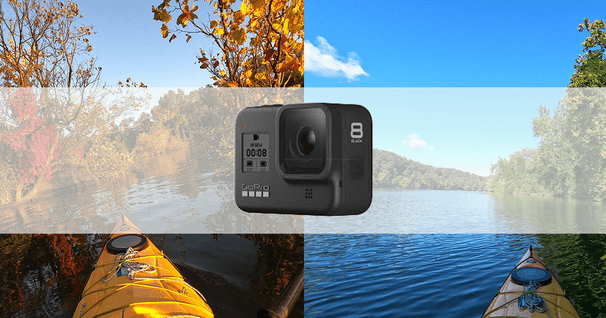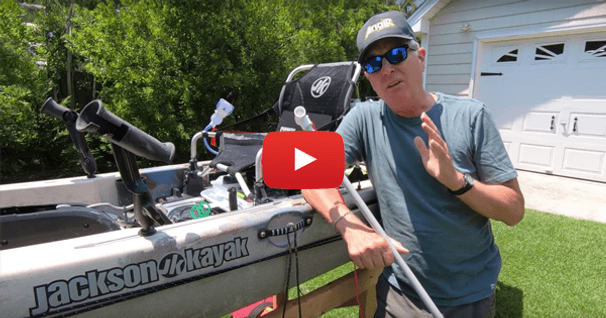Beyond the Warming Stone
Somewhere along Man's evolutionary association with fire, we learned that a stone magically took some of the heat from the fire and held on to it for a period of time. Long enough in some cases to add warmth to the animal hide under which the cave dwellers slept. It could also be used to carry along some of the heat of the fire when on a winter's hunt.
When I was a kid, technology has advanced the heating stone forward to the magical technology of carrying warmth in a small, metal flask-like container that actually housed a glowing bed of flammable material fed by a small source of ignitable fluid. I could carry a warming concentration of the campfire around in a little flannel pouch tucked into a jacket pocket - and feel its comforting heat all day long. As a kid growing up in Minnesota, I remember everyone who spent any time outdoors had his or her own Jon-e™ hand warmer - complete with its little red flannel pouch. It was our "warming stone".
Seek out a "hand warmer" today and the choices are staggering compared to yesteryear. Do you want a small, disposable packet that adheres to the sole of your feet to keep your toes warm (some are specifically called "toe" warmers)? How about a super-sized pouch that can warm an entire sleeping bag?
Besides a variety of uses, there are new ways to generate that heat, too. How about a crystallizing thermo-chemical reaction? We also have rechargeable heat sources and even a mini version of the old, reliable Jon-e.
Each different type and even some within the same type purposely vary the amount of heat they will generate. Because some reach projected optimum temperatures ten to thirty degrees less than others does not mean it's inferior; it's just suited for a different applications (do you need 140°F to provide lasting warmth to your fingers when 100°F works just fine?). Save the higher temps for ridding your boots of cold in the morning.
Here's a look at a variety of "warmers" available to outdoors enthusiasts today.
Dry Chemical Envelopes
Combine iron filings, water, cellulose or vermiculite, activated carbon and salt together and it generates heat when exposed to air (sometimes with a little agitated coaxing). Storing this mixture in a sealed cloth envelop creates a simple "carry-along" packet that, when agitated, generates up to 130-140°F of comforting warmth, sometimes for up to several hours. This is the principle behind most of the more inexpensive, disposable "warmers" on the market.
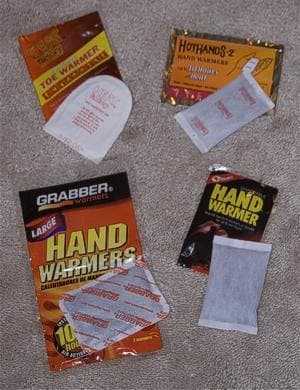
Some are called "Toe warmers", others "hand" warmers. Most manufactures offer several sizes and cloth pockets in which to place them for effective warming. Those designated for foot use typically have an adhesive backing that enables the user to keep it in place on the stockings covering the forward soles of one's foot - thereby reducing shifting during activity - or to stay where needed when sleeping. Common to all warmers is that they should be covered or wrapped (never in direct contact with skin!) to provide optimum heat over an optimum length of time. All dry chemical units are "one-time" use and disposable.
Be advised: Dry chemical pouches must stay dry. They are therefore not suited for on-water use nor in any environment in which they are in contact with moisture. Most work best in restricted air! Read the warning labels as some can generate over 150°F if misused! Most all performed equally well. All claim to be environmentally friendly.
Coughlans Disposable Warmers - Quick to warm, producing a higher upper temperature than most other packets of the same size. Also seemed to heat up faster than others. Coughlan's offers a variety of sizes for warming gloves and boots, and even larger areas of the body - claiming up to 12 hours of "instant heat". Like most of these "warmers", they are handy for storing in tackle boxes, glove compartments, first-aid kits, etc. Like other brands, Coughlan's have an expiration date stamped on the package.
Grabber® Warmers - Available in a variety of sizes, offering hand warmers and larger body warmers. "Toe warmers" have adhesive backs and are designed to be placed on the outside of a sock, over the toes. Grabber offers a fleece pouch for its "mega warmer" as its "sleeping bag warmer".
Heat Factory - Offers a variety of warmers, packaged like many others - either individually or in multiple packets. As is common, their "toe" warmers didn't reach as high of temperatures as did the "hand" warmer models.
HotHands-2 - These were slightly faster than others (except Coughlan's) to generate noticeable heat (ultimately up to six hours worth - as do the others). HotHands-2 also come in several sizes and can be purchased in multiple packets. They offer a heat range of 100°F to 130°F°. In my unofficial comparison, I would say the HotHands2 easily rivals the Coughlan's as far as the degree and duration of heat given off.
Pricing varies greatly among the brands, from $.50 each to $1.50 depending on size and multiple-unit packaging. All are priced to encourage buying several units at a time. Make sure you check out the expiration date as these units do degrade over time.
Liquid- Crystalization Pouches
If you take certain "salts" and add them to water to the point the water can absorb absolute no more of the chemical you create a "super" saturated solution. Agitate that solution and it immediately begins to crystallize -giving off significant heat in the process. Contain that reaction in a durable but flexible pouch and you now have a contained, controllable heat source - one you can carry with you. You can use the same pouch over and over again simply by melting the crystallized form back into a liquid state and reactivating it. That is the basic principle behind the liquid pouch "hand warmer".
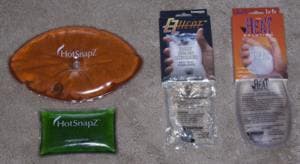
The "salt" used is sodium acetate, an industrial form used in everything from food prep' to leather tanning! The liquid is water. A metal disc used to trigger the crystallization is merely a device that, when clicked between the fingertips, agitates the supersaturated mixture to the point it starts to crystallize. Doing so releases energy in the form of heat. Since a crystal is mostly water anyway, all you need to do to turn it back into water is to heat it (in this case, to 160°F) to basically melt the crystal. The easiest way to do that is to drop the crystallized pouch into boiling water. Once all the crystal is completely melted, usually after about 10 minutes, the pouch is liquid again and can be re-used.
The advantage of the liquid pouch is that they come in waterproof pockets so you can use them in a wet environment (canoes and kayaks). They are the quick-fix warmers as they start to generate heat immediately (up to 130°F) and provide significant warmth for 30 minutes or more. They, too, should not be left against bare skin, but rather wrapped or contained in a cloth pouch or garment pocket. They, too, come in a couple of different sizes, basically a "hand" warmer size and larger "body" warmer size.
EZ HEAT™ /THE HEAT SOLUTION® - Both warmers are made by Pristech Products, Inc. and both kick out 130°F of heat within a few seconds of activation. The main difference in the two is how they are sold/marketed. The EZ HEAT is usually readily available as an impulse buy displayed at outdoor stores. It's comes in a vinyl envelope and it's one size is designed to be carried in the field.
The HEAT SOLUTION/Zap Pac - comes in several sizes and is marketed to cover broad medical/health uses. It has a sturdier nylon pouch. Like the EZ Heat, it can be boiled after crystallization for hundreds of reuses.
HotSnapZ™- Equally fast at producing heat, these warmers come in two useful sizes, too. The smaller pouch is within the standard dimension for similar hand warmers - about 3" x 4.5". The larger "body pouch" measures a whopping 8.5"x 5". A neoprene pocket is available as a jacket for the larger pouch. HotSnapZ also generates up to 130°F of heat for at least 30 minutes. (The company claims up to 2 hours of generated warmth). Its pouch is also reactivated by boiling.
Fuel burning/Battery Powered
The Jon-e™ seems to live on in the minds of those who remember it, and on websites that are last vestiges of where it can even be found. I get the impression that it is being phased out - check outdoor retailers' websites for retails options.
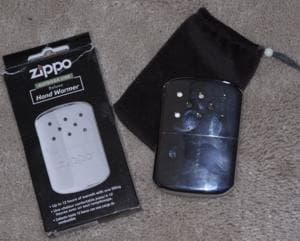
ZIPPO™ - There is at least one fluid fuel burning warmer on the market. It's made by Zippo and is about 60% of the size of its classic cousin. The principle behind the Zippo is that it's a hand-held catalytic heater of sorts. There is a fuel reservoir bottom to which a special wick inside the burner element is attached. The wick draws up the fuel into the burner element and is ignited by a flame. That flame starts the element smoldering and that generates literally hours and hours of heat. A hood is placed over the element and the enclosed shiny metal, flask-like container is slipped inside a fleece pouch ready for use.
Depending on the level of fuel used, the unit can burn for 6 or 12 hours. It does require a light fuel such as lighter fluid to work. It will take about 15 minutes to warm up after being lit. As part of my testing, I have in my pocket as I write, a very warm Zippo warmer that I filled and lit nearly 20 hours ago. It was sitting on a counter overnight and seems to be warmer since I put it back into my pocket again at about the 18-hour mark.
SANYO™ - There is yet another type of warmer that is perhaps more similar to heated socks than a chemical hand warmer. It's made by Sanyo and comes in two forms. Both are rechargeable battery powered. One is a "one-sided hand warmer" emitting heat only through an aluminum plate on the back. The other emits warmth from all sides. Both fit into the palm of your hand. They are rechargeable via either an internal Li-ion battery (heat to about 109°F - the 'one sider') or by rechargeable AA batteries (heat to 115°F). Both appear to be more related to home-use health applications than outdoor use. Perhaps these could take the chill off extremities while you wait for the fireplace to stoke up!
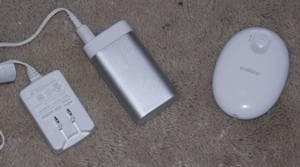
Words of Warmth & Wisdom
All hand warmers provided a modicum of heat. In severe field use, some may not muster enough BTUs to matter much, but when placed in a pocket, within inner layers, all would provide a noticeable point of heat radiating out. The dry powder units took longer to heat up but once they were activated and placed in areas of restricted air/ventilation (a critical condition of their optimum functioning) they all worked well - some more "well" than others.
The Zippo had the most staying power and stayed usefully hot the longest. The crystallized liquid pouches heated up the fastest, but didn't generate heat very long. For a quick fix, use the liquid pouch. For intermediate use, consider the dry pouches. For the long haul, the Zippo rules.
Remember these points when using a "hand warmer":
- Don't put the heating unit directly against bare skin.
- If left in the open, some dry units can get very hot! (150°F or more).
- Liquid pouches can be reused but need to be boiled (wrapped in a wash cloth or other heavier fabric so pouch doesn't come in contact with hot sides of boiling vessel).
- Boiling takes about 10 minutes and you must wait until the crystallization is completely liquid again. Even a sliver of crystal will cause it to recrystalize as it is cooling.
- Only the liquid/crystallization pouches should be used in wet environments.
- Carry several, toss into the toes of footwear to quickly warm toes and soles.
- Environmentally safe.
- Costs vary from $.50 to $4-6/pouch; $20 for the Zippo; $35+/- for the Sanyo.
A final word of warning: If a dry pouch is exposed to air, it will activate. If a crystal liquid pouch is jostled around or poked in a particular way, it too, will activate. If they are tossed in a pack, they could be useless when needed later. I once put a crystal pouch in my backpack and set off on a hike. Upon reaching my destination, I discovered that it had accidentally activated. It had been resting next to a package of chocolate bars. I was half way to "s'mores" before even lighting a fire! Once I learn how to roast a marshmallow with one, I will be set!
Be safe, stay warm and have fun out there!
Tom Watson is an avid sea kayaker and freelance writer. He also posts articles and thoughts on his website www.wavetameradventures.com. He has written 2 books,"Kids Gone Paddlin" and "How to Think Like A Survivor" that are available on Amazon.com.
Related Articles
~A Paddler's Post submitted by Gregg Jackson~ For decades I had combined the joys of hiking and…
Forget paddles and forget pedals, there is a new way to get from Point A to Point B in your kayak: Jet.…
Learn to make a good DIY stake out pole so you can save some money for other kayak updates!
Looking to step up your kayak fishing game? Check out how to add a fish finder to your YAK and soon…
